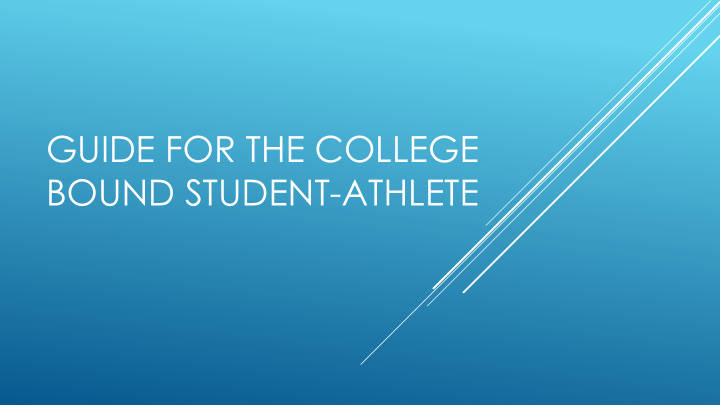



GUIDE FOR THE COLLEGE BOUND STUDENT-ATHLETE
Junior College – two-year institutions (Over 500 schools) NAIA – four-year institutions (251 schools) NCAA Division I – 351 schools – 59% receive athletic aid NCAA Division II – 308 schools – 62% receive athletic aid NCAA Division III – 443 schools – no athletic aid
Baseball Football Men’s Women’s Basketball Basketball High School 487,097 1,036842 551,373 412,407 Participants NCAA 35,460 73,557 18,816 16,614 Participants % High 7.3% 7.1% 3.4% 4% School to NCAA Drafted from 775 255 52 32 NCAA % NCAA to 9.8% 1.6% 1.2% 0.9% Professional COMPETING BEYOND HIGH SCHOOL
Athletic aid does not mean a full scholarship DI Head-Count Sports – Football, Men’s Basketball, Women’s Basketball, Women’s Gymnastics, Women’s Tennis, Women’s Volleyball – Any athletic aid counts as 1 scholarship – Limit on number of scholarships (DI Volleyball – 12). All other sports are equivalency sports – athletic aid/value of full grant-in-aid ($5,000 scholarship/$25,000 cost = .20 scholarship) Equivalency limits per sport – softball – Di 12, DII - 7.2 ATHLETIC AID
DI, DII, and DIII all differ in when contact with college coaches can happen. Division II Specifics… Unofficial visits (you pay expenses) may occur whenever and you get an unlimited number of them. June 15 preceding your junior year in high school Coaches can send you recruiting material (camp information can be sent to you at any time) Coaches an call you Coaches can have in-person off campus contact with College coaches may not send you recruiting materials until after June 15 th of your Junior year. They can send you camp information though if the camp is open to anyone. You can take an official (expenses paid) visit (only one per institution). You can have a tryout (only one per institution) RECRUITING
Degree Programs. Academic Resources. Financial Aid and Cost of Attendance. Admissions Requirements. Athletic Training and Medical Expenses. On-campus Housing and Meals. Coaching Philosophy and Style. WHAT TO ASK ABOUT
Start panning now by working hard to earn the best grades possible Ask counselors for a list of NCAA core courses to make sure you are taking NCAA-approved courses You can check your schools list of NCAA courses at eligibilitycenter.org GRADE 9 - PLAN
Register at eligibilitycenter.org Make sure you are studying and staying on track to graduate GRADE 10 - REGISTER
Make sure you are studying and staying on track to graduate When registering for the SAT and/or ACT have the scores sent to the Eligibility Center by using code 9999 At the end of the year have your official transcripts uploaded to the Eligibility Center GRADE 11 - STUDY
Make sure you are studying and staying on track to graduate Request final amateurism certification after April 1 At the end of the year have your official transcripts with proof of graduation uploaded to the Eligibility Center GRADE 12 - GRADUATION
SAT/ACT scores. Remember, 9999. Division I and Division II use a sliding scale to determine eligibility. SAT scores come from the sum of the critical reading and math sections. ACT score come from the sum of the English, math, reading, and science sections. WHAT THINGS WILL THE ELIGIBILITY CENTER NEED?
CORE GPA Minimum 2.3 for DI Minimum 2.2 for DII SAT AND ACT SCORE
This is an example of a sliding scale for NCAA Division II. You find whatever your core GPA was in high school and then you can determine what score you need on the SAT or ACT.
When you register with the NCAA Eligibility Center, you will be asked a series of questions about your sports participation to determine your amateur status. You can request your final amateurism through the NCAA Eligibility Center on or after April 1before the start of the fall academic year you are enrolling in. To find out more about what goes into determining amateurism, visit ncaa.org/amateurism AMATEURISM
Be realistic about your ability. Success is the student’s responsibility, not the parent’s.
EligibiltiyCenter.org ncaa.org/student-athletes/resources ncaa.org/student-athletes/future fs.ncaa.org/Docs/eligibility_center/Student_Resources/ CBSA.pdf USEFUL RESOURCES
Recommend
More recommend